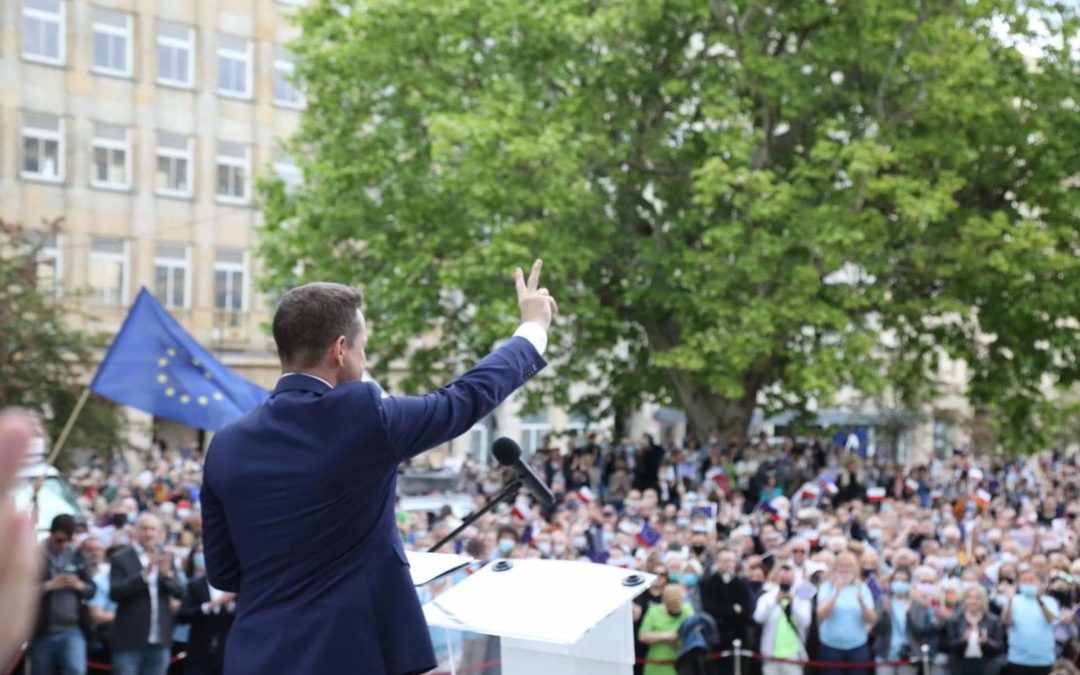By Aleks Szczerbiak
Following its postponement in May, Poland’s presidential election appears to be returning to its pre-pandemic dynamics as a closely fought plebiscite on the right-wing ruling party. A new liberal-centrist opposition challenger has made an energetic start, but the governing party-backed incumbent remains the favourite, albeit narrowly and in spite of the fact that he has lost momentum since the campaign resumed.
A crucial, closely fought election
Until the outbreak of the coronavirus pandemic crisis it was widely assumed that the most significant political event in Poland during the first half of 2020 would be the presidential election, scheduled for 10 May with a second round run-off a fortnight later between the two leading candidates if none secured more than 50% of the votes.
The election is crucially important because a victory for incumbent Andrzej Duda – who is supported by the right-wing Law and Justice (PiS) grouping, Poland’s ruling party since autumn 2015 – would give the government a three-year run without any national elections to continue implementing its programme of radical state reconstruction. However, given that the party lacks the three-fifths legislative majority required to overturn a presidential veto, Duda’s defeat would seriously hamper PiS’s ability to govern effectively and possibly precipitate an early parliamentary election.
Given his relatively high approval ratings, and the fact that he was Poland’s most trusted politician, Duda was widely assumed to be the favourite. At the same time, however, last autumn’s parliamentary election – when PiS retained its overall majority but lost control of the Senate, Poland’s less powerful second chamber – showed how evenly balanced support for the government and opposition was, with many voters determined to use any opportunity to block the ruling party. Although polls suggested that Duda would easily win the first round, given the deep polarisation of the political scene the second round run-off was expected to be extremely closely fought and unpredictable.
Benefiting from the “rally effect”
However, from the middle of March onwards, the ongoing pandemic crisis changed the dynamics of the presidential election campaign. Initially, PiS and Duda benefited from the so-called “rally effect”: the inevitable psychological tendency for worried citizens to unite around their political leaders and state institutions as the embodiment of national unity at times of a sudden and dramatic external threat.
PiS actively portrayed Duda as an integral part of the governing camp, giving the impression that the president was on the front line of the battle against the virus and making him the focus of a number of its daily briefings and key, headline-grabbing announcements of government programmes. As long as the government appeared to be trying to cope as effectively as it could with the crisis this strengthened Duda, and polls started to show that he could win a clear victory in the first round of voting.
In the event, the 10 May election never took place because legislation proposed by PiS that would have introduced universal postal voting to allay public safety concerns was not approved in time due to a split within the governing camp. The Polish State Election Commission (PKW), which is charged with overseeing the electoral process, simply declared the election invalid as there was no possibility to vote for any of the registered candidates.
The Polish parliament has now approved new legislation on the organisation of the presidential election that will involve a “hybrid” electoral system: with Poles either voting traditionally in polling stations (which would have to adhere to sanitary standards) or casting postal ballots if they chose to do so. At the time of writing, it is unclear when the election will be held, but PiS is determined that it should take place at the end of June so that the newly elected president can be sworn in before Duda’s current term of office expires on 6 August.
Jockeying among the opposition candidates
One of the most interesting features of the presidential election campaign has been the jockeying for position among the opposition candidates as to who would emerge as Duda’s main challenger. This is important because presidential elections have sometimes led to broader realignments within the Polish party system. Indeed, the liberal-centrist Civic Platform (PO), Poland’s ruling party between 2007 and 2015 and currently the main opposition grouping, itself emerged following the success of one of its founders, Andrzej Olechowski, in the 2000 presidential poll.
Until the pandemic, Duda’s nearest rival and most likely second-round challenger was PO candidate Małgorzata Kidawa-Blońska, who, at one point, was averaging around 25% support in opinion polls. However, even before the crisis changed the nature of the campaign, Kidawa-Błońska appeared to be a relatively weak candidate. An unimpressive public speaker with poor debating skills, her campaigning style and self-image as an emollient candidate of societal dialogue and reconciliation came across as too aloof and completely unsuited to a crisis situation when more decisive leadership was required. The final nail in her campaign’s coffin was Kidawa-Błońska’s half-hearted suggestion that a boycott of the May election might be necessary but without herself withdrawing from the race, which simply confused and demobilised her already declining electorate, and her poll ratings slumped to single figures.
Other opposition candidates saw Kidawa-Błońska’s decline in support as an opportunity to replace her as Duda’s main challenger. The most successful of these turned out to be the independent TV presenter and liberal-centrist Catholic journalist Szymon Hołownia. Before the pandemic crisis turned conventional politics on its head, Hołownia’s campaign had developed little traction.
However, the shift from traditional campaigning – where local grassroots organisation, financial resources, and access to the traditional media favoured candidates from the more established parties – to political communication primarily through the internet and social media, levelled the playing field somewhat and played to Hołownia’s strengths as a skilled direct-to-camera performer. As well as mopping up a swathe of disillusioned PO voters, Hołownia was able to make an attractive pitch as a non-party candidate that the many Poles who craved “newness” at a time of extraordinary politics were looking for. The “Ewybory” website, which aggregates voting intention surveys, showed his average opinion poll support increasing from only 5% at the end of March to 17.5% in mid-May.
A new, more formidable challenger
According to the revised electoral law, while candidates who were due to contest the 10 May poll can still run for the presidency at the later date, new ones will also be able to register. As a consequence, almost as soon as the election was postponed PO replaced Kidawa-Błońska with the party-backed Warsaw mayor Rafał Trzaskowski (who also held a number of ministerial positions in the previous government) as its presidential candidate. Trzaskowski is clearly a much more formidable campaigner than Kidawa-Błońska was, but his initial objective was simply to see off the challenge from Hołownia for the mantle of main opposition challenger to Duda.
Trzaskowski made an energetic start, travelling the country to hold “pre-campaign” meetings and with some clever initiatives that managed to put PiS on the back foot. For example, he capitalised on a row about the fact that “Your pain is better than mine” (“Twój ból jest lepszy niż mój”), a pop song satirising PiS leader Jarosław Kaczyński’s alleged violation of social distancing regulations, was pulled from Polish state radio’s playlists. Trzaskowski used this as a pretext to call for the scrapping of the state TV news and information service, which he described as a government propaganda tool (PiS argues that state TV’s current political stance simply brings pluralism and balance to a media landscape otherwise dominated by the party’s opponents). Ewybory found Trzaskowski quickly moving clearly ahead of Hołownia into second place, averaging 26.9% support by the end of May.
At the same time, the opposition’s prospects have been boosted by the fact that, as the perception of an immediate health crisis appeared to be subsiding somewhat, Poles started to focus increasingly on the worsening economic situation; one of the reasons why PiS wanted the presidential election to be held as soon as possible. Moreover, health minister Łukasz Szumowski – who, as the widely praised face of the government’s response to the pandemic crisis, was one of PiS’s most important political assets – found himself embroiled in allegations of conflicts of interests (he vehemently denies any wrongdoing). As a consequence, the government’s approval ratings started to decline and, according to Ewybory, Duda saw his voting support slump from a peak of 62% in mid-April to only 40.1% at the end of May.
Trzaskowski’s strengths and weaknesses
However, much of Trzaskowski’s surge in support almost certainly comes from PO voters who were planning to abstain but have now returned to the fold to back their party’s candidate. The Warsaw mayor, who is strongly identified with the party’s cultural liberal-left wing, also appears to have drained support from the “Left” (Lewica) candidate Robert Biedroń, whose campaign was already hamstrung by his perceived lack of gravitas; according to Ewybory, Biedroń’s poll support has slumped to only 3.8%.
Nonetheless, one of Trzaskowski’s greatest strengths, his credibility with urban liberals, is also his biggest weakness because it limits his appeal among voters who live beyond the metropolitan areas and whose support he will need to win. PiS will no doubt portray the urbane Trzaskowski as embodying the aloof and pretentious urban elites who look down upon the inhabitants of small-town provincial Poland. It will also highlight his socially liberal views on moral-cultural issues in order to polarise the campaign and thereby mobilise the core right-wing traditionalist electorate in smaller towns and rural areas where election turnout is traditionally lower.
For sure, the economic downturn undermines Duda’s original core appeal as the guarantor of the PiS government’s programme of hugely expanding very popular social spending and welfare policies while maintaining strong economic growth and reducing the budget deficit. PiS is now recalibrating this message to argue that it is the party best placed to oversee economic recovery through an ongoing programme of state-led reconstruction projects while protecting families and low income households.
At the same time, the party says that only Duda’s re-election offers governing stability at a time of ongoing epidemiological and economic crisis, arguing that Trzaskowski and other opposition candidates would simply use the presidency to undermine the PiS government and sabotage its policies. Trzaskowski has tried to counter this by saying that public spending should focus on improving the health service rather than large infrastructure projects and, while also arguing that the president needed to be more independent of the government, downplaying concerns that his election would lead to governing deadlock.
Back to pre-pandemic politics?
With the “rally effect” waning and voters starting to focus more on economic concerns, the dynamics of Poland’s presidential election campaign have once again changed. Public attitudes can, of course, shift very rapidly in what remains an extraordinarily fluid and dynamic political situation. But, in many ways, the election has simply returned to more familiar pre-pandemic tracks: an evenly balanced and closely fought plebiscite on the PiS government in which Duda remains the narrow favourite.
The president’s electoral strategy was premised on there being a May election, and he has clearly lost momentum since it was postponed and needs to reinvigorate his campaign; while Trzaskowski has made an energetic and dynamic start and put Duda on the back foot. But to win the opposition will need to come up with a convincing programmatic alternative on the socio-economic issues that Poles care most about, not just clever public relations stunts that dominate the news cycle for a couple of days.
Main image credit: Twitter/Rafał Trzaskowski





















